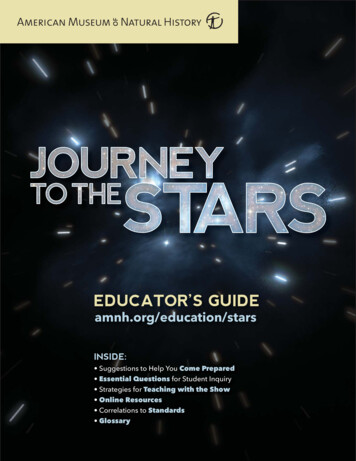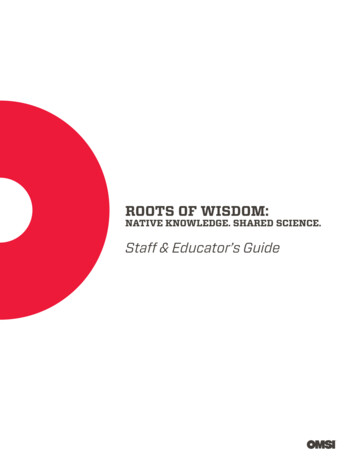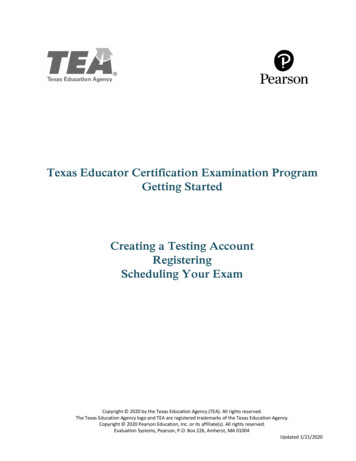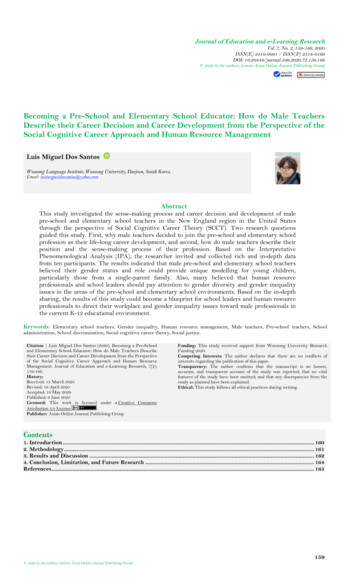
Transcription
EDUCATOR’S GUIDEamnh.org/education/starsINSIDE: Suggestions to Help You Come Prepared Essential Questions for Student Inquiry Strategies for Teaching with the Show Online Resources Correlations to Standards Glossary
ESSENTIALQUESTIONSJourney to the Stars explores the birth, life, and death of stars, and why they are important to us. Use theEssential Questions below to connect the show’s themes to your curriculum. (Bolded terms are found inthe glossary.)What is a star?Why are stars important?A star is a huge glowing ball of hot gas, mainly hydrogenand helium. The temperature is so high in its core thatnuclear fusion occurs, producing energy. The outwardpressure of gas heated by fusion is balanced by theinward pull of gravity, leaving the star in hydrostaticequilibrium. This balance of forces lasts for most ofa star’s life, maintaining its steady temperature. Radiation and convection carry the energy from the core outthrough a star’s atmosphere. When the energy gets highenough in the atmosphere that the region above it istransparent, it escapes out into space as light of all wavelengths, as well as stellar wind. Though stars may appearstatic, they rotate and vary in luminosity. There arehundreds of billions of stars in the Milky Way Galaxyalone. Among them is our Sun, the closest star to Earth.Without stars, we wouldn’t be here at all. At the beginning of the universe, the only elements that existed werehydrogen, some helium, and trace amounts of lithium.All other naturally occurring elements were formedduring the life and death of stars. At the end of a star’slife, much of its matter is blown into space, where itprovides the gas and dust for building new stars, planets,and everything on them including our bodies. Closer tohome, when our Sun was born, its gravitational forceheld gas and dust in orbit, allowing for Earth’s formation.Now the Sun holds the planets in their orbits, heats thesurface of Earth, drives Earth’s dynamic climate, andfuels photosynthesis.Where do stars come from?Every star forms in a huge cloud of gas and dust. Overtime, gravity causes the cloud to contract, drawing thegas closer and closer together. As more gas accumulatesat the center, it becomes denser and pressure increases.This causes it to heat up and begin to glow. Its gravitycontinues to pull in gas and dust, further increasing itsmass, and thus its pressure and temperature. Eventually, the center reaches millions of degrees Celsius—hotenough to fuse hydrogen nuclei and generate intenseenergy. The heat generated by nuclear fusion causesthe gas at the center of the star to expand, exertingan outward pressure. When hydrostatic equilibrium isreached, a star is born. Nuclear fusion powers the staruntil it eventually runs out of fuel and dies. Most starsform in tightly packed groups called star clusters, fromwhich the majority are eventually ejected.How do stars differ?Though stars may look like similar points of light fromour perspective on Earth, they actually differ fromeach other in many ways. Stars vary in their mass, size,temperature, color, luminosity, and age. They differ intheir distance from Earth, and some orbit one or moreother stars. They also change over the course of theirlives. A star’s mass determines its temperature andluminosity, and how it will live and die. The moremassive a star is, the hotter it burns, the faster it usesup its fuel, and the shorter its life is. The hottest andmost massive stars are blue and bright, while thecoolest and least massive stars are red and dim.Stars arefactories fornew elements.As they liveand die, theyform almostall of theelements onthe periodictable. Theseelements makeup Earth—and us.How do scientists study stars?We can see stars with the naked eye. But to observethem in detail, we depend on technology on the groundand in space. Ground-based telescopes enable scientists to see visible light, radio waves, and some infraredlight. Satellites that orbit Earth, orbit the Sun, or journeythrough space allow scientists to observe light at allwavelengths, free from the blurring and obscuring effectsof Earth’s atmosphere, and also enable them to samplethe solar wind. In the lab, scientists conduct experimentsto infer atomic and molecular properties of stars, and toinvestigate how nuclear fusion works. Finally, scientistsuse theoretical modeling and computer simulations tocompute how the properties of stars (such as density,pressure, velocity, or composition) change over time.
HOW DO WE KNOW?COME PREPAREDObservationsBefore you visit, review the Essential Questions to see how theshow’s educational themes connect to your curriculum. Considerwhat you would like your students to learn before, during, andafter your trip.Aside from dark matter, all objects in theuniverse emit light. Almost everything weknow about these objects—from their chemicalcomposition to their temperature to their age—comes from studying this light, only a fraction ofwhich is visible to the human eye. Sophisticatedtelescopes capture different wavelengths oflight, like X-rays and microwaves. This enablesastrophysicists to investigate distant celestialobjects. For example, they use cutting-edgeobservational techniques to see small, dim objects like brown dwarfs. On Earth and in space,these telescopes are our eyes to the universe.Models & SimulationsTelescopes can provide snapshots of celestialobjects in different stages of development.However the time scales are often just too longto see them in action. So, to help them understand billions of years of stellar history, astrophysicists create mathematical models that arebased on the laws of physics to describe hownature behaves across the cosmos. They sometimes use powerful computers to make vastnumbers of complex calculations to simulatethe life of stars. Astrophysicists compare thesemodels and simulations to observational datafor verification. The visualizations in Journey tothe Stars are based on both numerical modelsand observational data.Visit amnh.org/education/stars to:1. Download activities. You may wish to use these activitiesbefore, during, and after your Museum visit to focus yourexperience around an educational theme: Ecosystems and food webs (grades 3-5) Sizes and distances of celestial objects (grades 6-8) Life cycle of stars and the light stars emit (grades 9-12)You and your class chaperones can use some of the activitiesto guide you through suggested exhibitions after the show.2. Plan your visit. Find important information on reservations,logistics, and lunchrooms.NOTE: Please plan to arrive at the planetarium show boardingarea, located on the 1st floor of the Rose Center, 15 minutesbefore the show starts.CORRELATION TO STANDARDSYour viewing of Journey to the Stars can be correlated to thestandards below. Visit tml for a full listing of relevant NYS Science CoreCurriculum Standards and NYC Scope & Sequence topics.National Science Education StandardsComputer simulationscan follow the motion ofgas in three dimensionsto represent the interiorof the Sun.All Grades A1: Abilities necessary to do scientific inquiry A2: Understanding about scientific inquiry E1: Abilities oftechnological design E2: Understanding about science andtechnology G1: Science as a human endeavor G2: Natureof scienceGrades K-4 B1: Properties of objects and materials B2: Position and motion of objects B3: Light, heat,electricity, and magnetism C3: Organisms and environments D2: Objects in the sky D3: Changes in Earth and skyThe results of suchsimulations can bevisualized to revealwhat happens beneaththe Sun’s surface.Here we can seeswirling currents ofgas that carry theSun’s energy outward.Grades 5-8 B1: Properties and changes of properties in matter B2: Motions and forces B3: Transfer of energy D3: Earth inthe Solar SystemGrades 9-12 B1: Structure of atoms B2: Structure andproperties of matter B4: Motions and forces B5: Conservation of energy and increase in disorder B6: Interactions of energy and matter D1: Energy in theEarth system D4: Origin and evolution of the universe
TEACHINGWITH THE SHOWTo support a class discussion after viewing Journey to the Stars, you may wish to review the main contentpoints from each section of the show (bolded terms are found in the glossary) and then use the GuidingQuestions (answers available at tml).1. Introduction We live on a planet that orbits a star that is one ofhundreds of billions in our galaxy.Visualizations ofthe Sun and Earthare created fromobservations madeby scientists usingboth ground-basedand space-basedtelescopes. Our star, the Sun, is a middle-aged yellow star ofsomewhat above average mass. Without nurturing light that carries energy from ourSun, life as we know it would not exist. And without the elements formed by stars that livedand died billions of years ago, we—and everythingaround us—would not exist.2. Stellar HistoryGUIDING QUESTIONSAll Grades What have you learned about stars? Why are stars important to us? How do scientists study stars? How do they studythe Sun?Grades 3–5 What is the Sun? How is the Sun important? How are stars the same? How are they different?Grades 6–8 How does the Sun affect Earth? How is our Sun similar to or different from otherstars? What are star clusters? What is mass? How does mass relate to gravity? What are the stages of the life of a star?Grades 9–12 What does the Sun emit? How do stars form? Why do stars shine? What does the color of a star indicate? How does life depend on ancient stars? How might the Sun impact future stars? How does the discovery of brown dwarfs expandour understanding of stellar objects? Over 13 billion years ago (300 million years afterthe Big Bang), all that existed in the universe was darkmatter and the elements hydrogen, helium, and traceamounts of lithium. Dark matter’s gravity gatheredthe gas to form the first stars. Over the next few billionyears, stars were born more rapidly than at any otherperiod in the history of the universe. Stars now form ata rate one-tenth as high. About 4.5 billion years ago, within the Milky Way Galaxy,our Sun was born from a dense cloud of gas and dust,along with hundreds to thousands of other stars in astar cluster. As happens with many young stars, our Sunwas ejected from its cluster. Since then it has traveled,along with its planets, in orbit around the center of theMilky Way. Except for hydrogen and helium, all the naturallyoccurring elements come from the life and death ofstars. Together, they make up all the matter of daily life. Stars are different masses, temperatures, and colors.More massive stars are hotter and bluer, while lessmassive stars are cooler and redder. Yellow stars arein between.Scientists usesupercomputer models tounderstand star formationand star clusters. The firststars were massive—theyburned hot and heatedthe surrounding gas (red,purple, white filaments).They lived fast and diedyoung in supernovaexplosions (white regionin center).
3. The Life of Stars: Our Sun as an ExampleThe Voyager SpaceProbe has detectedthe outer edge of theSun’s solar wind andmagnetic field, wherethey encounter thesurrounding interstellar gas. Thismission has extendedthe human footprintto the edge of theSolar System—it hastraveled the farthestfrom Earth of anyhuman-made objects. Nuclear fusion in the core of the Sun generates energy(light of all wavelengths) that diffuses partway out asradiation. Energy is then carried the rest of the way tothe surface by convection. The Sun, like all stars, performs a balancing act to keepitself together: the enormous outward pressure of hotgas is balanced by the inward pull of the Sun’s owngravity. This is called hydrostatic equilibrium. The Sun continuously blasts a solar wind made up ofcharged particles (protons, electrons, and heavier ions).Magnetic explosions called solar flares produce stormsin the solar wind and generate radiation. In rare cases,such storms can disrupt radio, cell phones, and GPS,or even cause blackouts on Earth.4. Death of a Star: Our Sun In 5 billion years, our Sun will run out of fuel. Nuclearfusion in the core will cease, generating less energy, thepressure pushing outward will dwindle, and gravity willwin. The outer layers will swell into a red giant, andultimately blow out into the universe ejecting matterthat may someday form other stars and planets. Thecore will collapse into a white dwarf. It will take tens of billions of years for the white dwarf,the remnant of our Sun, to cool and fade away. This isthe way that nearly all stars end their lives.Scientists find hugestellar nurseries likethe Orion Nebulathroughout the MilkyWay Galaxy and theuniverse today.Towards the end of its life, the Sun will become a red giant. Its outerlayers will swell towards Earth.5. Our Solar Neighborhood The stellar life cycle continues today. Stars still form,live, and die. The young Orion Nebula contains oneof many clusters of newborn stars in the Milky Way.Some of them are just forming planets. The Pleiades, a mature star cluster, is ejecting stars. The HelixNebula was expelled by a star at the end of its life. A brown dwarf shares properties of both starsand planets, having a mass that’s in between. Forevery star like our Sun, there are hundreds of browndwarfs. Scientists do not fully understand theseobjects or how they relate to planets and stars. On Earth, the stars that we see in the night sky—and theone that we see during the day—each tell a story.Scientists alsoobserve the remainsof stars, like the HelixNebula, within whichthe star’s core hasalready contractedinto an extremelydense white dwarf.
ONLINERESOURCESAll GradesMiddle & High SchoolJourney to the Stars for Educatorsamnh.org/education/starsFree online resources and fieldtrip information.Sun-Earth Daysunearthday.nasa.govExtensive educational guides, activities, and imagesrelated to the Sun, as well as information about theSun-Earth Day program, which celebrates a differentaspect of NASA Sun-Earth Connection research each year.Cullman Hall of the Universeamnh.org/rose/universe.htmlVivid animations of stellar life cycles in the “Stars Zone”include a high mass star that swells into a red giant anda low mass star that becomes a white dwarf.Solar & Heliospheric Observatory (SOHO)soho.nascom.nasa.govNearly up-to-the-minute images of the Sun and a fullrange of educational resources, including a very informative “Sun 101” resource and access to solar n plans, activities, and information about thestructure and workings of the Sun.Elementary & Middle SchoolAstronomy OLogyamnh.org/ology/astronomyHands-on activities and articles related to astronomy, suchas a Stargazing Sky Journal, Build the Big Dipper Mobile,One-on-One with the Sun, and Planetary Mysteries.Solar System sson plans and activities related to NASA missionsthroughout the Solar System, as well as profiles of themen and women involved in NASA’s space exploration.Discovering the Universeamnh.org/resources/moveable astroCurriculum materials that explore stars and othercelestial bodies, and demonstrate how astrophysicistsanalyze their distant light for clues to their physical andchemical properties.Science Bulletinsamnh.org/sciencebulletinsVideos, interactives, and essays that introduce studentsto current research in astrophysics. Check out the Astrofeatures and snapshots, including “SALT: Imaging theSouthern Sky,” “Sloan Digital Sky Survey: Mapping theUniverse,” and “Earth’s Magnetic Shield.”Chandra X-Ray Observatorychandra.harvard.edu/edu/Information and activities related to the Chandra X-RayObservatory, which scientists use to study high-energyregions of space, such as the remnants of supernovas.How Stars Workhowstuffworks.com/star.htmInformation about the properties and life cycles of stars.See also: howstuffworks.com/sun.htmCREDITSJourney to the Stars was developed by the American Museum of Natural History, New York (www.amnh.org)in collaboration with the California Academy of Sciences, San Francisco; GOTO INC, Tokyo, Japan; Papalote Museo del Niño, Mexico City, Mexico and Smithsonian National Air and Space Museum, Washington, D.C.Journey to the Stars was created by the American Museum of Natural History, with the majorsupport and partnership of NASA, Science Mission Directorate, Heliophysics Division.Photo CreditsSun insert: Layers of the Sun diagram andthe Sun in three wavelengths, NASA.All other images: American Museumof Natural History.Made possible through the generous sponsorship ofAnd proudly sponsored bySupercomputing resources provided by the Texas Advanced Computing Center (TACC) atThe University of Texas at Austin, through the TeraGrid, a project of the National Science Foundation.The Museum gratefully acknowledges Celeste Sant’ Angelo and Stephen Kovalfor their support of this Educator’s Guide. 2009 American Museum of Natural History. All Rights Reserved.
amnh.org/starsJOURNEY TO THE STARSABOUTTHE SHOWWe travel to the present day, zooming inon our Sun, to see how stars work. The Sun’sThe journey begins onEarth, where we baskin the warm rays of thesetting Sun. We lift offand travel out beyond ourSolar System, and even beyond the edge of our galaxy.We then jump over 13billion years into the past,to a time when there were no stars at all.In this primeval state, there was only an invisiblesubstance called dark matter, along with hydrogen andhelium gas. But soon, the first shining stars appeared.They burned hot, lived fast, and exploded in incrediblesupernovas that blasted new elements out into space.These new elements provided the essential rawmaterials for building new stars, planets, and, eventually,even life. The gravity of dark matter collected gas intogalaxies—more and more galaxies formed, along withmore and more stars within them. One of the galaxieswas our own Milky Way.Our journey brings us forward in time toabout 4.5 billion years ago, when our veryown Sun was born. A cloud of gas and dust, somewhere in the Milky Way, formed stars of many differentmasses and colors. Within this tightly packed group ofstars, called a star cluster, was our young Sun. The intense light and heat of themassive bright stars dispersedthe surrounding cloud ofgas and dust. The mostmassive stars lived onlybriefly and exploded ingigantic supernovas.Eventually, the lessmassive stars were flungout of the cluster—some,like our Sun, with planetsalready formed andorbiting around them.layers are revealed from the outside in: the milliondegree corona blasting out a solar wind, the photosphere with its darker sunspots, and, below that, thetumultuous currents of hot gas churning above theradiant interior. The Sun’s core is where nuclearfusion happens: atomic nuclei fuse together, releasingimmense amounts of energy. Pulling back fromthe Sun, we see how its churning outer layers generatea vast magnetic field, and a stunning visualization thenreveals how the Sun’s magnetic field and solar windextend across the Solar System. Earth’s own magneticfield almost always shields it from the dangerous blastof charged particles—only a trickle of solar wind getsthrough, sliding down to the poles and producingradiant displays of light calledauroras. A quick jumpto the future, 5 billionyears from now,reveals our Sun atthe end of its life,as it expands intoa red giant andthen sheds itsouter layers intospace. All that isleft is a white dwarf,the hot denseremnant of the Sun’score, which will cooldown over billions of years.Our journey returns us to the present, toexplore stars in our galactic backyard thatare going through all these processes now.We visit the dazzling Orion Nebula, Pleiades, andHelix Nebula to observe stars being born, beingejected from star clusters, slowly dying, and sheddingmatter that may someday form other stars and planets
ally, the center reaches millions of degrees Celsius—hot enough to fuse hydrogen nuclei and generate intense energy. The heat generated by nuclear fusion causes the gas at the center of the star to expand, exerting an outwa











